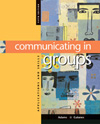The Symbolic Nature of Emoticons Most computer-mediated communication is text based. That is, communication
with other people takes place by typing messages on a computer keyboard. Because
CMC relies on text for meaning, much emotional content normally expressed nonverbally
(e.g. happiness, sadness, confusion, etc.) is not present in CMC interactions. To adapt to the CMC medium, Internet users have developed a symbolic code to
express emotion. Known as "emoticons," certain combinations of characters
are used to indicate relational messages in e-mails, online chats, bulletin
board messages, and other CMC channels. Examples of emoticons include: :) A basic smiley face ;) A smiley face with a "wink." Used to indicate playfulness or sarcasm. :') A smiley face indicating "I'm so happy I'm crying." The popularity of emoticons has led to other text-based symbols finding their
way into the common written vocabulary of Internet users. For examples, LOL
means "I Laughed Out Loud at what you wrote." And IMHO means "In
My Humble Opinion," which is often used to precede a controversial opinion.
The following websites provide dictionaries of emoticons and other text symbols
used in CMC: http://members.aol.com/bearpage/smileys.htm http://www.techdictionary.com/chat.html How do you think emoticons and other online lingo illustrate the notion of
structuration discussed in this chapter? | 


 2003 McGraw-Hill Higher Education
2003 McGraw-Hill Higher Education